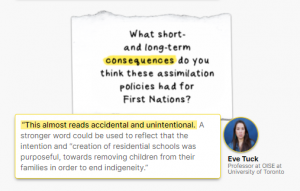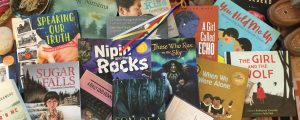The Endangered Languages Project is a global initiative maintained by the Catalogue of Endangered Languages (ELCat) project, at the University of Hawaiʻi at Mānoa. The website conatins a plethora of information and resources for endangered languages world wide. Their section for Canada contains 73 languages to explore. Introducing a website such as this in the middle years classroom would benefit students’ thinking around language and colonization. The maps included on the website may be used to spark inquiry projects around why certain languages are endangered.
Category Archives: MODULE 3
Module 3 Post 3: Speak Gwich’in To Me Documentary
Jacey Firth-Hagen is the creator of the social media language revitalization awareness initiative “#SpeakGwichinToMe” which promoted the use and learning of the Gwichin language (the most endangered Athapaskan (Dene) language in the Northwest Territories). Her motivation stems from the empowerment she felt from learning more about her culture and language. Her movement led to the creation of the Speak Gwich’in To Me documentary, free to view. Jacey is one of many Indigenous activists working to support language preservation and revitalization in Canada. Her advocacy is admirable and educators can benefit from hearing what she has to say in terms of which languages and how languages are taught in our education system.
Module 3 Post 2: Hul’qumi’num Language and Culture in Nanaimo-Ladysmith
The school district of Nanaimo-Ladysmith (SD 68) on Vancouver Island provides quite a robust Indigenous education program, and more specifically a Hul’qumi’num Language and Culture curriculum. Their website contains resource packages including lesson plans developed by the Hul’qumi’num Language Stakeholders group for grades 5-12. These resources provide good examples of how languages might be preserved and valued in public schools. Exploring the Indigenous languages of Canada also helps to decolonize the education systems in which we currently work in.
Module 3 Post 1: TRC Calls to Action
The Truth and Reconciliation Commission’s 94 Calls to Action is a list of items crucial to repairing the damage and intergenerational trauma brought upon Indigenous peoples in Canada. The document is designed as an outline of necessary work to be done collaboratively between Indigenous and non-Indigenous governments at all levels. Calls #13-17 specifically mention language and culture. These calls to action serve as a starting point to which many dying Indigenous languages may be preserved and enriched.
Module 3, Post 5 | NY Times: The Politics of Geography through Textbooks
This article looks at eight textbooks in use in the states of Texas and California and deconstructs the power of narrative and language in establishing a politic agenda. American journalist Dana Goldstein has spent years investigating how Americans learn and this project highlights the profound impact on how what we’re told is authoritative can influence our live choices and behaviour.
https://www.nytimes.com/interactive/2020/01/12/us/texas-vs-california-history-textbooks.html
Module 3, Post 4 | A History of American History Textbooks
This article picks apart the slow and painful path of American textbooks from pure propaganda to inexplicably delusional. The article is important for me because it synthesizes some of the fundamental problems with textbooks, the importance of writing for a specific audience, and the recognition that readers are shaped by narratives framed as authoritative. Also discussed are the implications of including multimedia elements, like images, and how selected images can have a lasting (positive/negative) impact on readers.
https://www.vox.com/identities/2019/8/26/20829771/slavery-textbooks-history
Module 3, Post 3 | Decolonizing the Curriculum
An informative and expansive primer on what the decolonization process should look like in a higher education context. Complete with links, videos, tips, and history this article is a good starting point for understanding the importance of decolonizing the curriculum, or any educational content, and how to go about getting started.
https://medium.com/hindsights/what-would-it-mean-to-decolonize-the-curriculum-4fcedbe781d1
Module 3, Post 2 | Two Indigenous Scholars on History Textbooks
OISE professors Jennifer Brant and Eve Tuck unpack a section of a Grade 8 history textbook (published by Nelson) on the topic of residential schools. They raise important points about the application of soft language and the framing of history as incidental or accidental. This is in line with my paper topic on the role textbooks publishers play, as well as the potential impact of the tone they take and the narratives they prioritize.

https://www.thestar.com/news/gta/2021/06/26/two-indigenous-scholars-read-a-history-textbook-chapter-on-residential-schools-this-is-what-they-would-change.html
Module 3, Post 1 | People for Education
This not-for-profit organization is “independent, non-partisan, and fueled by a belief in the power and promise of public education.” In 2016 they published a report called “What Matters in Indigenous Education: Implementing A Vision Committed to Holism, Diversity, and Engagement,” authored by Pamela Rose Toulouse.
This publication makes a strong argument for the universal application of Indigenous learning principles in education and educational material. Much like the mathematics discussed in the Nicol at al. article we recently read, it highlights the importance in connecting theoretical and abstract learning principles to real life through problem-based inquiry.
https://peopleforeducation.ca/report/what-matters-in-indigenous-education/
M3P5: Books to Build On: Indigenous Literature for Learning

This University of Calgary website, in combination with Indigenous and non-Indigenous people, offers a curated list of Indigenous books suitable for all ages (from child to university student). As a bonus, they have also included lesson plans with most of the books. I considered my knowledge of Indigenous books suitable for my class to be well developed, and this resource offered new books to add. In particular, I like that it is not limited to social studies or language arts (where indigenous content is often included), but rather focuses on all the subject areas (including science, math, etc).